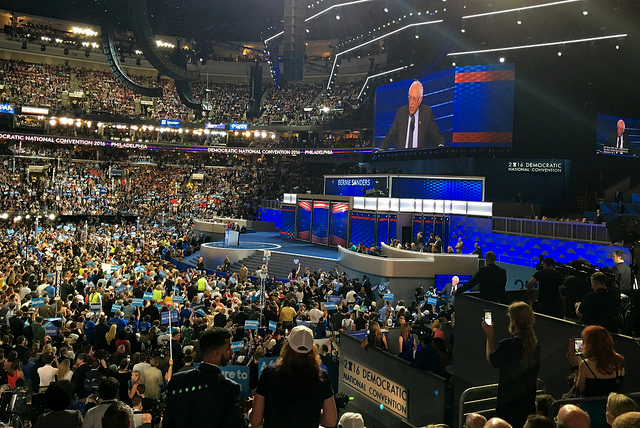Our Revolution is just getting started
By Peter Olney and Rand Wilson
Now that the Democratic National Convention in Philadelphia has ended with Hillary Clinton as the party’s nominee, Bernie Sanders’ campaign for “political revolution” moves to its next phase.
Everyone who supported Labor for Bernie is very proud of the of the unprecedented grassroots effort to rally rank-and-file members on his behalf. A network of tens of thousands of supporters (largely recruited via the Labor for Bernie website and social media), campaigned in nearly every union to get trade union organizations to endorse Bernie.
By the end of the campaign, six national unions and 107 state and local union bodies endorsed Bernie. Just as importantly, Labor for Bernie activists kept many Internationals and the AFL-CIO on the sidelines during the primaries; enabling their members to more actively support Bernie.
But it wasn’t just about endorsements. Labor for Bernie was an all-volunteer army; a movement of members and leaders who took on the labor establishment. Labor for Bernie activists formed cross-union groups in dozens of states and many cities. They generated strong working class support for Bernie’s candidacy and carried his message into thousands of workplaces. They worked independently of the Sanders campaign, but in tandem with it.
Particularly in the later primaries (WI, IN, PA, CA) workplace outreach helped to identify new Bernie supporters and get them to turnout on Primary Day. In many states, the majority of union households went for Bernie, often accounting for his margin of victory.
Democratic National Convention
More than 250 Labor for Bernie delegates from 37 states attended the Democratic National Convention in Philadelphia (and undoubtedly there were many more). Labor for Bernie leaders played a key role in fighting for a more progressive platform and for changes in the rules that could make the Democratic Party a more open and populist party in the future.
These changes were negotiated between the Sanders and Clinton campaigns just prior to the convention. As a result, there was little for the Sanders’ delegates to do at the convention. Yet despite the compromise agreement on the platform, there was widespread concern among delegates that the platform didn’t have strong enough language opposing the Trans-Pacific Partnership (TPP).
A Labor for Bernie leader from Illinois printed up 2,000 “No TPP” signs. The printer folded them twice so that our network of delegates could more easily smuggle them onto the convention floor.
When the platform came up for a vote, Labor for Bernie helped orchestrate “No T-P-P” chanting by the delegates that briefly brought the convention to a standstill. It captured the attention of the national news media.
Outside the convention there were spirited mass rallies in support of Bernie’s candidacy and the environmental and labor issues brought forward during the campaign. National Nurses United organized a forum on Medicare for All. Union supporters held a forum on organizing to stop passage of the TPP during the Congressional “lame duck” session after the November 8 election.
The small but feisty Working Families Party hosted a forum with speakers discussing ways to build an autonomous and independent faction inside the Democratic Party. Democratic Socialists of America had a standing room only session on the lessons of the Sanders campaign.
Delegates were grouped by their state both on the convention floor and in their hotels. There were obvious and deep differences in the political perspectives of the Sanders and Clinton delegates. One group apparently satisfied by the status quo in the Democratic Party, the other determined to change it. Sanders’ delegates often felt they were “crashing” someone else’s party.
Just prior to the start of the convention, WikiLeaks revealed emails showing widespread favoritism and manipulation by the Democratic National Committee to assist Clinton in the primaries. This confirmation of what many already suspected enraged many Sanders delegates and at times tensions flared in arguments both about the conduct of the party and debates on the issues.
The shared experience among the 1,900 Sanders delegates may be the one of the most important lasting outcomes of the convention.
The political revolution doesn’t end in Philadelphia
Union members allied with Labor for Bernie now face the dual challenge of decisively defeating Donald Trump and stopping the Trans-Pacific Partnership (TPP) treaty.
Yet, as Bernie argued at the Convention, we can’t allow this election to become only about the differences between Trump and Clinton. Wherever possible, we have to continue to inject our issues into this general election campaign.
And that’s where “Our Revolution,” a new organization that is emerging from the Sanders’ campaign, comes in. It will continue to bring together a new majority for economic and social change by supporting candidates at the local, state, and national level who support the mission, issues and values of the Sanders campaign.
Sen. Sanders will provide more specifics in a “live stream” video presentation set for the evening of August 24. Many of Bernie’s volunteers in the labor movement will be hosting events in their union halls or living rooms to help kick off “Our Revolution” and lead this effort.
The Sanders’ campaign showed how unions might engage in politics in ways that enhances membership involvement and organizational clout, rather than reducing it. When labor organizations decide to endorse candidates, after a democratic process open to the entire rank-and-file, it changes the whole dynamic of union-based political activism. As a labor network strongly in favor of this approach, there will be a continuing need at the local, state, and national level to back electoral campaigns inspired by Bernie’s run for president.
Wilson’s pictures from the convention are online here

Pingback: Winning the Rank-and-File Vote
Looking forward to “Our Revolution” ! we have a great start and now, let’s not drop the ball!